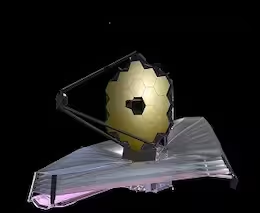James Webb Space Telescope | JWST
Have you see images of nebula and galaxies by JWST ? Read how this space telescope captures these striking images. Explore the instruments on James Webb Telescope and how they make new discoveries of the cosmos.

James Webb cannot see visible light. It sees the universe in IR light.
How JWST looks back in time
Infra red rays from objects in the early universe are left behind in space.
IR photos captured by James Webb Space Telescope show objects in the early universe, shortly after the big bang.
Like mobile phone cameras, cameras on JWST use color filters to capture the same image in different colors. They are converted to electrical signals and transmitted back to Earth.
Back on Earth, images recreated from digital signals are stretched, combined and processed to make stunningly beautiful photos of the past.

Instruments on JWST
Spectrographs on James Webb Space Telescope split incoming light into different wavelengths and show the brightness of each wavelength. Spectrographs from JWST help scientists identify atoms and molecules in the atmosphere of exoplanets. It also shows temperature, density and movement of stars, exoplanets and galaxies.

Coronographs are special disks that block light from bright stars. When James Webb Space Telescope searches exoplanets for life, stars near the planet are so bright that it hides the planet from view. Coronographs block light from bright stars, enabling JWST to study exoplanets.
Coronographs also help observe young solar systems. Solar systems are surrounded by gas and dust during the formation stage. Using Coronographs, James Webb Space Telescope can look beyond the dusty surface to show how planets are created in young solar systems.
Aperture Mask is a mask with hexagonal holes. Viewing cosmic objects through this mask reduces glare. It helps James Webb Space Telescope do high resolution observations on extremely bright objects in space.
Why is JWST special
Apart from standard picture modes, JWST uses different modes to take photos of space.
Coronograph Mode can take pictures of faint objects by blocking bright light from nearby stars.
Aperture Mode uses aperture mask to take high resolution images of small objects. In this mode, detailed photos of small objects are combined to make a high resolution image of the wide field.
Time Burst Mode take images of the same object at different intervals of time. It shows how a star changes over time or how a planet moves with time.
